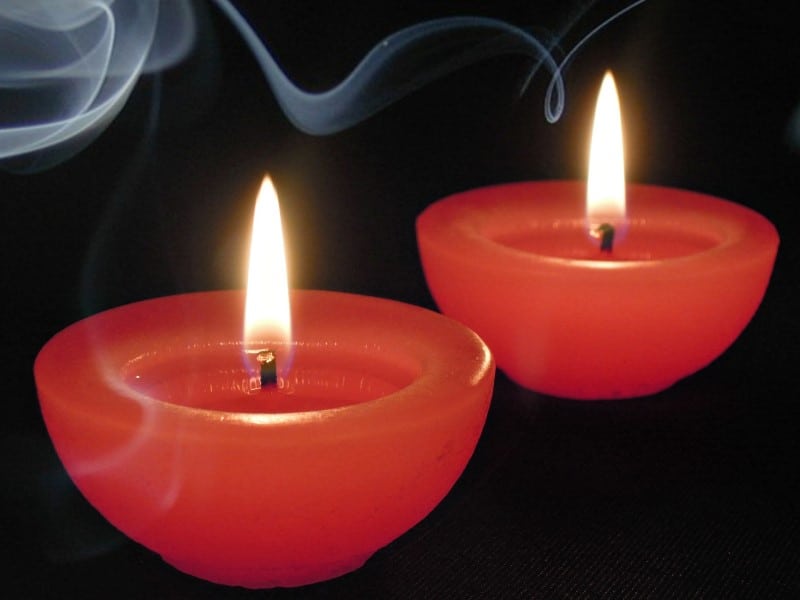Candles are centuries old and have been a main staple in society for lighting and beautiful smells. While the transformation of candles has shifted over the years into more decorative items rather than practical uses, there is still more to them than just wax.
In the modern age, we find ourselves mindlessly lighting a candle to create a specific mood or atmosphere, giving little to no thought as to what is behind that flame. Sometimes, candles can emit a bit of black smoke. But why?
When black smoke starts coming from our candles, we find ourselves asking “why does my candle have black smoke?”. Black smoke coming from a candle is directly related to an excessively long wick. If a wick is too long, the wax is not being pulled up the wick far enough, causing excessive soot. When this soot builds up and starts to be burnt when a candle is lit, black smoke it the end result. Black smoke can also be related to the melted wax pool around the wick having too much soot build-up mixed in. When the candle burns, this soot draws into the wick, causing a black smoke emission!
Black smoke from soot is horrible smelling and looking. The most effective way to put an immediate end to this problem is to practice proper candle maintenance. Candle maintenance starts with trimming the wick.
Trimming the wick with a wick trimmer (a special tool that can reach safely into a candle jar) or pair of scissors is absolutely essential. Only about 1/4in to 1/8in of wick needs to be removed to keep a wick working properly.

Candles have a bit of science behind them that directly relates to wick trimming. If a wick isn’t trimmed properly, it causes the black smoke. It also can cause soot build-up in the wax pool at the base of the wick. The science behind how wicks work can be simplified down to the wax vapors that chemically react to the wick being lit.
When the wax is drawn up the wick and then combined with being ignited, magic happens. This magic is summed up as wax vapors breaking down, creating soot.
This “magic” doesn’t seem very pleasant and honesty, it is not! That is why ensuring the wick stays trimmed is absolutely critical. It keeps the science behind the burning in check as well as the production of soot in line.
Read more about Why Should You Trim Your Candle Wicks.
How Often Should I Trim the Wick?
Wicks are a standard part of a candle, as they are the literal light and flame of the candle. However, not candles are the same. There is some debate behind how often to trim a wick of a candle. One of the key aspects of trimming a wick is to examine it while it is burning and after it’s been extinguished.
If there seems to be a bit more soot or black smoke coming from the candle, then trimming more often may be necessary. This can even be after every burn (after the candle is cooled!) or before lighting the candle as well.
While the key is to check out if there is soot or black smoke to the candle, some can follow a general rule of thumb. One side of this debate states before every burn is necessary while others would state every 4 to 5 burns is sufficient.
Once again, this will differ from candle to candle. The type of wax can be incorporated into this inspection as well. However, the main thing to remember is to trim the wick as needed.
Why is the specific length to trim a wick set at 1/4in to 1/8in? This very small measurement is considered the best to trim a wick because is just enough to keep a clean burn on the wick.
Anything more than this can result in the wick becomes too short and the flame not staying lit on the wick. Once again, as stated, a wick that is too long will result in soot and black smoke. Keeping a watchful eye and maintaining a proper trim schedule will keep wicks operating at their best!
Why is Soot Such a Problem?
Soot might seem like a basic problem for some people, however, there is much more to the black smoke that comes from built-up soot. As with cleaning schedules or maintenance of other household things, proper care of our candles ensures that this is reduced greatly.
So what is the big deal with soot? Below are the main issues that soot can cause for homeowners.
Soot: A Lingering Issue
Causes the appearance of mold
Soot can build-up over time, encasing some items in the home with a black tint. This can be on nearby curtains, pillows, or even walls. This black coloring is often mistaken for black mold, especially if a candle is burnt in areas like a bathroom or kitchen where water sources are located.
This mistake might cause a homeowner to spend unnecessary money trying to fix a mold problem that doesn’t exist. A stark comparison to this issue would be to think about people who smoke in their homes. Their walls often get tinted yellow without them realizing it.
While black is darker than yellow, this perspective helps to notice how smoke can attach to walls and surrounding items.
Can enter ventilation systems
Soot does have chemical properties to it, specifically carbon. When it exposed to areas for a prolonged period of time, it can enter ventilation systems in the home. This can travel all throughout a home and is not good for those suffering from things like asthma or COPD.
Always take this into consideration when using a candle. Ventilation systems are delicate areas of the home and can cost a lot of bucks to get clean. This is why having candles in a well-ventilated area, away from these systems is ideal.
These are the two main problems with soot lingering around the house. Other ways that soot builds up is related to narrow candle containers (that restrict any airflow to the flame) and cheap, greasy feeling candles. Try to get quality candles that have smooth, soft textures to the top.
What Other Solutions are There for Soot Build-Up?
Soot, the culprit behind that pesky black smoke, can also form on the surface of the wax pool that sits at the base of the wick. Keeping this area clean is important as well since the wax here draws into the wick when burned.
Using a damp cloth, after the candle is completely cooled, will take care of this issue. However, there are other things to consider doing to help reduce the amount of soot being released and building on our candles! Below are some key tips for this issue!
Tips for Reducing Soot and Black Smoke Problems
Always extinguish the flame properly
Wick trimming is the top way to reduce soot amounts, however, extinguishing the flame plays a part in this as well. When it is time to put a candle out, properly snuffing the flame will help reduce the amount of soot released.
There are three main ways that are effective ways to put out a flame. The first, and easily most effective way for soot reduction, is a wick dipper tool. This tool pushing the wick tip into the melted wax pool at the base of the candle quickly putting the flame with little to no soot.
A candle snuffer, a long metal pole with a small bell on the end, fits over the wick top to put out the flame. The last way is by using the candle lid if its flame-proof. It will smother the flame and trap soot underneath.
Open some windows
After putting the flame out, open some windows. Some fresh air coming in will do some good in the house. Moreso, it allows for any lingering soot particles to escape out the open window. This is a great way to do help reduce soot build-up and it doesn’t cost a single dime!
The more windows you can open, the better. Obviously, if it is raining, don’t open them far, somewhere between 5 to 10 inches can make all the difference!
Invest in an “illuma-lid”
Yankee Candle has been around for quite some time and their innovation in the candle world is impressive. This is especially true with their illuma-lid. This special lid is a decorative and fits over glass jars shaped like Yankee Candle jars.
This makes them exclusive, but not impossible to use. This lid allows for light to pass through and various scents but puts a stop to excessive soot release. Moreover, it doesn’t put out the flame because the design of the lid has patterns cut out to allow proper airflow to the flame.
Look for the mushroom shape of doom!
Okay, it isn’t really the mushroom shape of doom, however, it does look creepy! Longer wicks will curl under and create what is called a “mushroom shape” out of the excess wick. When people suggest trimming the wick of a candle, they don’t always bring up this tell-tale sign of a wick that is simply too long!
If you notice this overlapped mushroom shape, put the flame immediately (safely, with a snuffer or otherwise!) and allow it to cool so you can trim the wick. This is yet another reason to keep up with cutting down the wick.
While soot cannot be completely avoided, these tips help reduce it. Having a cleaner burn while using candles is not only important for our health but also for our other household items. Don’t let the black smoke or soot deter you from enjoying your favorite candles!
